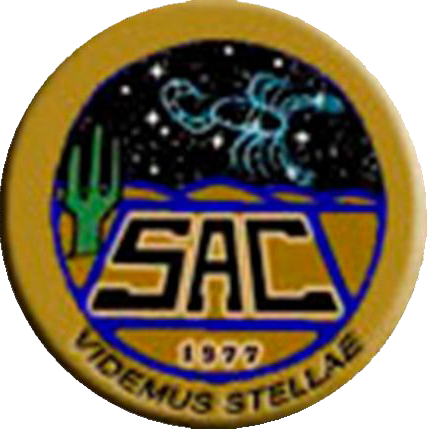by Steve Coe and A.J. Crayon
Monitored by the Novice Group
This award program provides beginning observers motivation for observing objects within the Solar System. A variety of observing techniques are needed. The movement of the planets, a meteor shower and the large glowing phenomena of the Solar System can be seen with the naked eye. Binoculars are excellent for a fine comet or bright asteroid. A telescope will be needed for a detailed view of the planets.
Taking on this project in earnest will also mean an investment in some resources to provide an observer with information on these objects. Any of the better computer programs will provide positions and much other data concerning objects in the Solar System. SAC members have had success with Guide, Megastar, The Sky and Skymap. The Observer’s Handbook by the RASC is a wealth of information about the year’s astronomical events.
The observations for this project must be typed or neatly handwritten and must contain this information at a minimum: date, time, sky conditions, instrument, magnification and filters used, location. Answer the questions for each object thoroughly and add your own personal notes for that observation. Drawings are not necessary for the award, but are highly recommended as a method of capturing what you see at the eyepiece. When you have completed the project allow the Novice Group Chair to review your observations. If all is well, your award will be presented at a club meeting so the entire membership can share in the joy of your accomplishment.
Mercury
You must observe this object on two nights that are far enough apart so that you can see the movement relative to the stars.
Did you find it? What did it look like? What is the phase?
Venus
You must observe this object on two nights that are far enough apart so that you can see the movement relative to the stars.
Did you find it? What did it look like? What is the phase?
Mars
You must observe this object on two nights that are far enough apart so that you can see the movement relative to the stars.
Did you find it? What did it look like? You must observe Mars with a large enough aperture telescope to be able to see 5 features of the Red Planet. Look for dark markings, light polar caps and white clouds. Hints: use at least 150X magnification and try some color filters. Did you draw this planet?
Jupiter
You must observe this object on three observing sessions far enough apart so that you can see movement in the four major satellites of Jupiter. Hint: that will be at least an hour apart. On the ball of the planet look for the Great Red Spot, dark belts, light zones and festoons. Did you draw this planet?
Saturn
You must observe this object on three observing sessions far enough apart so that you can see the movement of three major satellites of Saturn. Hint: the satellites of Saturn are fainter and generally slower moving than the satellites of Jupiter. Within the Rings look for thin, dark gaps between the major ring segments. Did you draw this planet?
Uranus, Neptune and Pluto
You must observe these objects on two observing sessions far enough apart so that you can see the movement of these planets among the stars. Hint: these planets are much farther from the Earth than the previous objects and move much slower. Did you find these objects? What can be seen at high magnification? Can you identify the brightest satellites of Uranus or Neptune? Special note for Pluto: because it is so dim, Pluto may not be seen with a modest scope at a mediocre site, therefore you will be given the award if you observe Pluto using a larger telescope that is not your own.
Meteors
Observe a meteor shower from an out-of-town site, any of the more well-known showers is fine. How many meteors did you count? Were all the meteors part of the shower? Were you able to see a radiant for the shower meteors? Did you observe any fireballs?
Comets
Find three comets. Hint: Sky and Telescope magazine will give the positions of known comets that are returning to a position that is near to the Earth. Did you draw these comets? Observe one of these comets on two nights far enough apart so that movement is seen.
Did you see a nucleus, coma or tail?
Asteroids
Find three asteroids. Hint: Sky and Telescope will give positions of the brighter asteroids that are easily observed. Observe one of these asteroids on two nights far enough apart so that movement is seen.
Glows
Observe the zodiacal light. Hint: this will require a transparent night away from the lights of the city. Did you observe this glow?
Can you see the gegenschein?
Sunspots
Observe sunspots on two different days so that you can see the movement of these dark markings across the disk of the Sun.
Hint: Be Careful!
Learn the dangers of solar observing and don’t damage your precious eyesight. Use your telescope to project the image of the Sun or use a solar filter. Can you see the umbra and penumbra? Did you draw the sunspots?
